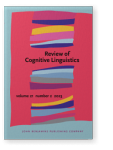Vol. 21:2 (2023) ► pp.542–575
Paradigms as second-order schemas in English noun-participle compounding
In Cognitive Linguistics, the noun-participle compound is a grammatical category with instances of different degrees of membership. The purpose of this study is to explore the categorization processes and schematic networks in noun-participle compounding. Working with the data of noun-participle compounds from COHA, we identified three types of participles: deverbal, denominal and ambicategorical. Two schemas [Nj-Vk-ed]A and [Nj-Nk-ed]A are established as generalizations of compounds of deverbal (e.g. man-made) and denominal participles (e.g. life-sized). Compounds of ambicategorical participles (e.g. snow-covered), are sanctioned by two schemas simultaneously, which give rise to ambiguous morphological readings. This study confirms the labor division between mother-daughter links and sister links in a schema network. The higher-level generalization is encoded by paradigmatically-related sister schemas, with the sister relations built on the shared structure links and a bi-directional conversion of the stem of ppl (i.e., noun-to-verb or verb-to-noun). The sister schemas as a paradigm is a more parsimonious generalization of the compounds, than the posited mother schema.
Article outline
- 1.Introduction
- 2.The cognitive approach to morphology
- 2.1Categorization and expansion of a schema network
- 2.2Sister links as paradigmatic relations
- 2.3Calibrating the past-participle morpheme
- 3.Methodology and data
- 3.1Dataset
- 3.2Data sorting
- 4.Results and discussion
- 4.1Schema [Nj-Vk-ed]A: Compounds with deverbal ppl
- 4.2Schema [N-N-ed]A: Compounds with denominal ppl
- 4.3Paradigmatic relation between [Nj-Vk-ed]A and [Nj-Nk-ed]A: Compounds with ambicategorical participles
- 4.4Expanding the schema network
- 5.Conclusion
- Notes
-
References
